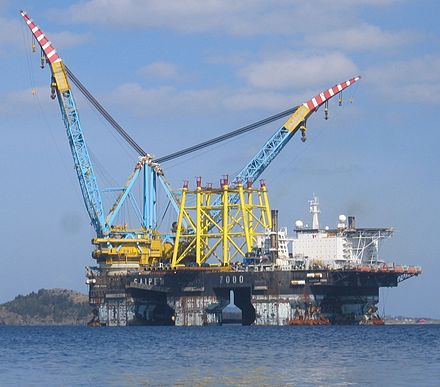Bouri Field
The Bouri Offshore Field is part of Block NC-41, which is located 120 kilometers (75 mi) north of the Libyan coast in the Mediterranean Sea. It was first discovered in 1976 at a depth of 8,700 feet (2,700 m) and is estimated to contain 4.5 billion barrels (720,000,000 m3) in proven recoverable crude oil reserves and 3.5 trillion cubic feet (99 km3) of associated natural gas with an annual production potential of 6 billion m³. Bouri is considered the largest producing oilfield in the Mediterranean.[1]
In 1974, the Italian oil company Eni S.p.A. signed a Production sharing agreement (PSA) awarded by the state-owned National Oil Corporation (NOC) of Libya for onshore and offshore exploration in areas near Tripoli. This is where the Bouri field was discovered offshore at a depth of 8,700 feet (2,700 m) in the Gulf of Gabes by Eni's subsidiary company Agip Oil in 1976. The Bouri field is jointly operated by Agip and NOC.
The first phase of development, costing nearly $2 billion, was completed in 1990. This was immediately followed by commencement of a second development phase which entailed the drilling of 55 new wells and construction of three additional platforms, with production initiating from two oil platforms (DP4 and DP3) in August 1998.
In 1995, the Bouri field was producing nearly 150,000 bbl/d (24,000 m3/d), followed by a sharp decline to 60,000 bbl/d (9,500 m3/d) in 1998. This decline was largely a result of the country's inability to import enhanced oil recovery (EOR) equipment under United Nations sanctions, specifically Security Council Resolution 883 of November 11, 1993, which banned Libya from importing refinery equipment. The situation has improved since the UN Security Council officially lifted sanctions against Libya during September 2003 and foreign investment is expected in the future. In 2006, Eni reported that the Bouri field was producing about 55 kbboe per day.[2]
Block NC-41 contains three known petroleum reservoirs; one oil reservoir and two gas reservoirs. NC-41 has two production platforms: DP4 and DP3. The latter is tied back to the DP4 platform located 6.5 km northeast. The DP4 platform is permanently moored at a single point to a Floating Storage and Offloading (FSO) tanker with a storage capacity of approximately 1.5 million barrels (240,000 m3). Bouri has three subsea wells independently tied to the DP3 platform by underwater safety valves (USV) mounted on a subsea-deployed skid located 150 meters from the DP3 jacket. The three wells were initially drilled in 1994-1995 and temporarily abandoned until completion in 1998. The subsea trees are an integral protection structure for deflection and protection, preventing the release of oil or gas from wells into the environment and controlling formation fluids. The wells, notable for Hydrogen sulfide, are controlled by chokes on subsea trees. Hydrocarbons are produced by their respective underwater safety valves to the DP3 platform through flexible 4" nominal-diameter flowlines. Topside controls were installed by FMC Technology on the DP3 platform and use a multiplex electro-hydraulic control system with independent production umbilical at each well.

